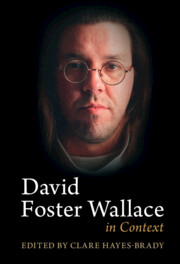Book contents
- David Foster Wallace in Context
- David Foster Wallace in Context
- Copyright page
- Contents
- Figures
- Contributors
- Acknowledgments
- Abbreviations
- Introduction
- Part I Contexts
- Part II Ideas
- Part III Bodies
- Part IV Systems
- Chapter 26 Infinite Jest as Opiate Fiction
- Chapter 27 David Foster Wallace and Racial Capitalism
- Chapter 28 Language and Self-Creation
- Chapter 29 Very Old Land
- Chapter 30 David Foster Wallace’s Ecologies
- Chapter 31 “I Could, If You’d Let Me, Talk and Talk”
- Chapter 32 David and Dutch
- Chapter 33 David Foster Wallace and Publishing
- Chapter 34 Author Here, There and Everywhere
- Works by David Foster Wallace
- Bibliography of Secondary Sources
- Index
Chapter 26 - Infinite Jest as Opiate Fiction
from Part IV - Systems
Published online by Cambridge University Press: 18 November 2022
- David Foster Wallace in Context
- David Foster Wallace in Context
- Copyright page
- Contents
- Figures
- Contributors
- Acknowledgments
- Abbreviations
- Introduction
- Part I Contexts
- Part II Ideas
- Part III Bodies
- Part IV Systems
- Chapter 26 Infinite Jest as Opiate Fiction
- Chapter 27 David Foster Wallace and Racial Capitalism
- Chapter 28 Language and Self-Creation
- Chapter 29 Very Old Land
- Chapter 30 David Foster Wallace’s Ecologies
- Chapter 31 “I Could, If You’d Let Me, Talk and Talk”
- Chapter 32 David and Dutch
- Chapter 33 David Foster Wallace and Publishing
- Chapter 34 Author Here, There and Everywhere
- Works by David Foster Wallace
- Bibliography of Secondary Sources
- Index
Summary
In 1996, the year Infinite Jest was published, the Federal Drug Administration approved Oxycontin as a prescription drug, a move that would have dire repercussions for Americans’ relationship to opiates. Indeed, Wallace’s novel appeared at a pivotal moment in what is now considered the opiate crisis. Drug use, of course, appears throughout Wallace’s fiction, including the pot-smoking LaVache of The Broom of the System, the numerous addicts in Infinite Jest, and the amphetamine-popping Chris Fogle in The Pale King. Wallace’s work fits into a long tradition of drug use and recovery in fiction, a genre that reaches back to Homer, Thomas De Quincey, William Burroughs and many more. This chapter will argue that Wallace’s fiction marks a sociopolitical shift in this genre: the commercialization of addiction under late capitalism. This approach to Wallace’s work will, like the recent Cambridge Companion and Marshall Boswell’s latest monograph, further thicken our understanding of Wallace’s literary and sociocultural context.
- Type
- Chapter
- Information
- David Foster Wallace in Context , pp. 283 - 292Publisher: Cambridge University PressPrint publication year: 2022

